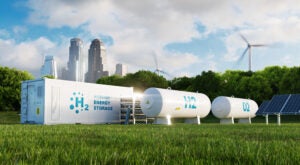By Ilissa Ocko and Steven Hamburg
Hydrogen emissions from leakage, venting and purging leads to global warming, new research confirms. To take advantage of the potential benefits of switching from fossil fuel systems to hydrogen, we need to keep emissions at a minimum, and doing so will depend on the development of new instruments that can detect even small leaks, allowing us to minimize them in the future.
A new paper published this summer in the journal Communications Earth and Environment uses five different climate models that show consistent results on hydrogen’s global warming potential at the 20, 100, and 500 year ranges. These results align with other recent studies.
In the new study, six groups of scientists reached the conclusion that hydrogen has 12 times the warming power of CO2 pound for pound over 100 years after release. It’s even more powerful in the first 20 years, when it packs more than 35 times the climate warming of CO2.
Hydrogen in the atmosphere behaves differently than CO2. While it doesn’t trap heat itself, the roughly one quarter of hydrogen emissions that isn’t taken up by microbial activity in soils leads to a chain of chemical reactions in the atmosphere that increase the amounts of other potent short-lived GHGs (methane, ground level ozone and upper atmosphere water vapor). These warming impacts are short-lived, both because hydrogen’s lifetime is short, and because its indirect effects through increasing GHG amounts only last a few decades. Thus, it’s important to evaluate its warming impacts on both short- and long-term warming potential timescales.
New research reaffirms hydrogen’s impact on the climate, provides consensus Share on XA milestone for consensus
This study provides a critical step in our understanding of the climate implications of hydrogen systems. It brings together the work of 11 scientists from the US and Europe, and builds upon more than a dozen peer-reviewed papers published over the last 20 years. By providing the first inter-model comparison, the authors have produced a robust assessment of hydrogen’s global warming impact.
This is the type of study that the Intergovernmental Panel on Climate Change depends on when reporting on warming effects. The timing of this study is, however, not ideal, because the next IPCC Assessment won’t be published until 2028 at the earliest. Furthermore, the last IPCC report to include hydrogen’s warming effect was published in 2007 and did not include all atmospheric warming effects — leading to an underestimate of hydrogen’s warming impact by a factor of two.
The authors of this new study clearly state that the results of hydrogen’s warming impact are robust enough to utilize to take action. Stakeholders should not wait for the next round of IPCC reports to incorporate hydrogen’s warming effects into policy and business decisions. If they do, we will miss major opportunities to prevent and minimize hydrogen emissions as governments and companies scale infrastructure to replace fossil fuels.
Time for action
There’s enough information to act now to prevent future hydrogen emissions. The authors of this new study are clear that the science is robust enough to “be used in various mitigation policy decisions, by comparing different GHG reduction measures, or life cycle analysis.” This study provides the robust level of confidence in our understanding of hydrogen’s warming power that stakeholders desire.
Given what we know about hydrogen’s warming effects, we must act now to prevent and minimize future hydrogen emissions. For starters, we need to include hydrogen’s warming effects in impact analyses tools like the Greenhouse Gases Regulated Emissions and Energy use Transportation life cycle assessment model, so we can more accurately capture the climate impacts of different hydrogen technologies, such as fuel cell vehicles.
We also need to take steps today to limit hydrogen emissions as new infrastructure is planned and built. That includes redesigning systems so that hydrogen is not vented or purged into the atmosphere unless absolutely necessary to mitigate non-routine safety concerns. Minimizing emissions also comes with safety and financial benefits, because hydrogen is both flammable and valuable.
We also need to continue to invest in new instruments that are required to quantify the rate of hydrogen emissions. It’s critical that we determine how much hydrogen is currently emitted across the value chain, so we can reduce and prevent future emissions and identify and prioritize best practices when building new infrastructure.
Future areas of study
The study authors echoed previous scholarship, noting that more research is needed to gain additional clarity around hydrogen’s sinks, like how much hydrogen is consumed by microbes in the soil — who ingest hydrogen as an energy source — versus how long it sticks around in the atmosphere leading to warming. Our current understanding of the key processes in the hydrogen cycle is strong, but additional measurement data will help reduce uncertainty. Additional, ongoing research around hydrogen’s sinks doesn’t in anyway limit the importance of minimizing hydrogen emissions or being confident in the benefits of doing so.
Hydrogen as an energy carrier holds substantive promise to assist humanity in addressing the climate crisis, but we must integrate its potential climate impacts into our considerations if we want to realize its potential. The science is clear: hydrogen emissions pack a significant warming punch in the near-term. If we want to rely on it as a clean energy carrier, we need to do everything we can to minimize emissions.










